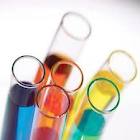Optimisation of Heterogeneous Catalysed Esterification Reaction for n-Hexyl Acetate Synthesis part 4
Friday, December 30th, 2011 4:04:00 by Ahmed Tariq
Optimisation of Heterogeneous Catalysed Esterification Reaction for
n-Hexyl Acetate Synthesis part 4
Batch Kinetic Studies
Figure 2 is the image of batch reactor apparatus used to conduct the
n-hexyl acetate esterification reaction. The apparatus consisted of a jacketed five necked batch reactor A stirrer motor was connected to the batch reactor via middle neck to agitate the reaction mixture. The front right-hand side neck of the reactor
was used to take samples of reaction mixture. A condenser was fitted into the rear left hand side neck of the reactor.
Temperature of the reaction mixture was observed by means of a digital thermocouple that was inserted in the rear right hand side of the batch reactor. The reaction mixture was heated through the jacket of the reactor by a water
bath. Measured amounts of acetic acid and n-hexanol were introduced into the jacketed stirred batch reactor. After allowing the reaction mixture to attain steady state i.e. desired temperature, the first sample was taken.
The time at which the first sample was withdrawn was taken as zero time i.e. t = 0. At the same time, the desired amount of catalyst was also added into the jacketed stirred batch reactor through the sample port. The samples were
taken at specified time intervals. Weighed amounts of acetone [~0.4ml] and n-butanol were also added to the samples for the purpose of GC analysis.
Temperature of the reacting mixture was maintained at a desired set value with uncertainty of ± 3 K throughout the whole reaction time of 6 h. Effect of various parameters such as speed of agitation, catalyst particle size, mole
ratio of n-hexanol to acetic acid, concentration of acetic acid (w/w), reaction temperature, catalyst loading (w/w), and reusability of the catalysts were studied for optimization of the reaction conditions.
Analysis of the Samples
The samples collected were analysed by Agilent Technologies 7890 series gas chromatograph (GC). Figure 3 shows the chromatogram of one of the sample. An HP-Innowax column (supplied by Agilent Technologies) was used to separate
all the components present in the sample mixture.
High-purity (99.9%) helium was used as the carrier gas. The detector and the injector temperatures were maintained at 550 K and 540 K respectively. Ramp method was used to
Tags: Catalysed, e biz, Esterification, findings, Heterogeneous, linkedin, Optimisation, personal computing, researchShort URL: https://www.newspakistan.pk/?p=7778

















